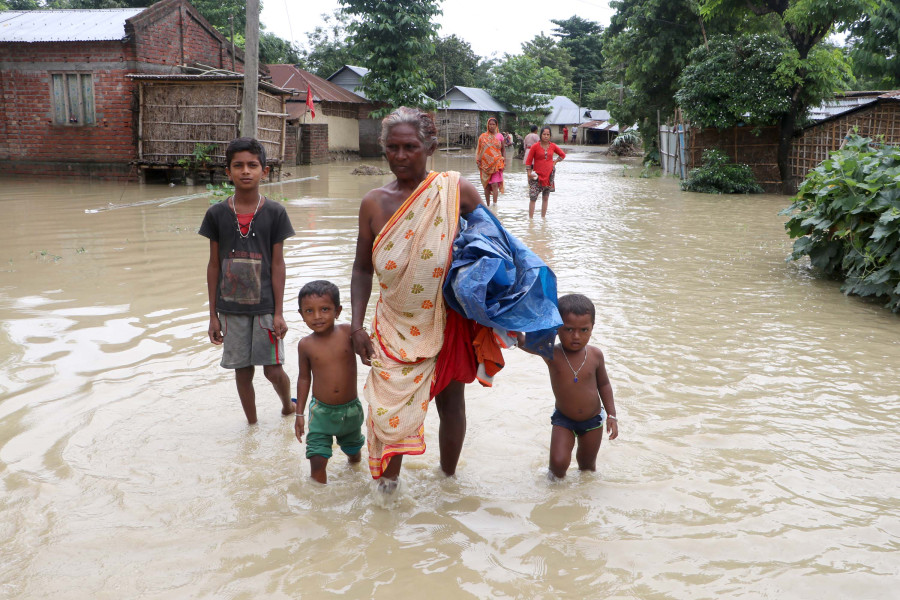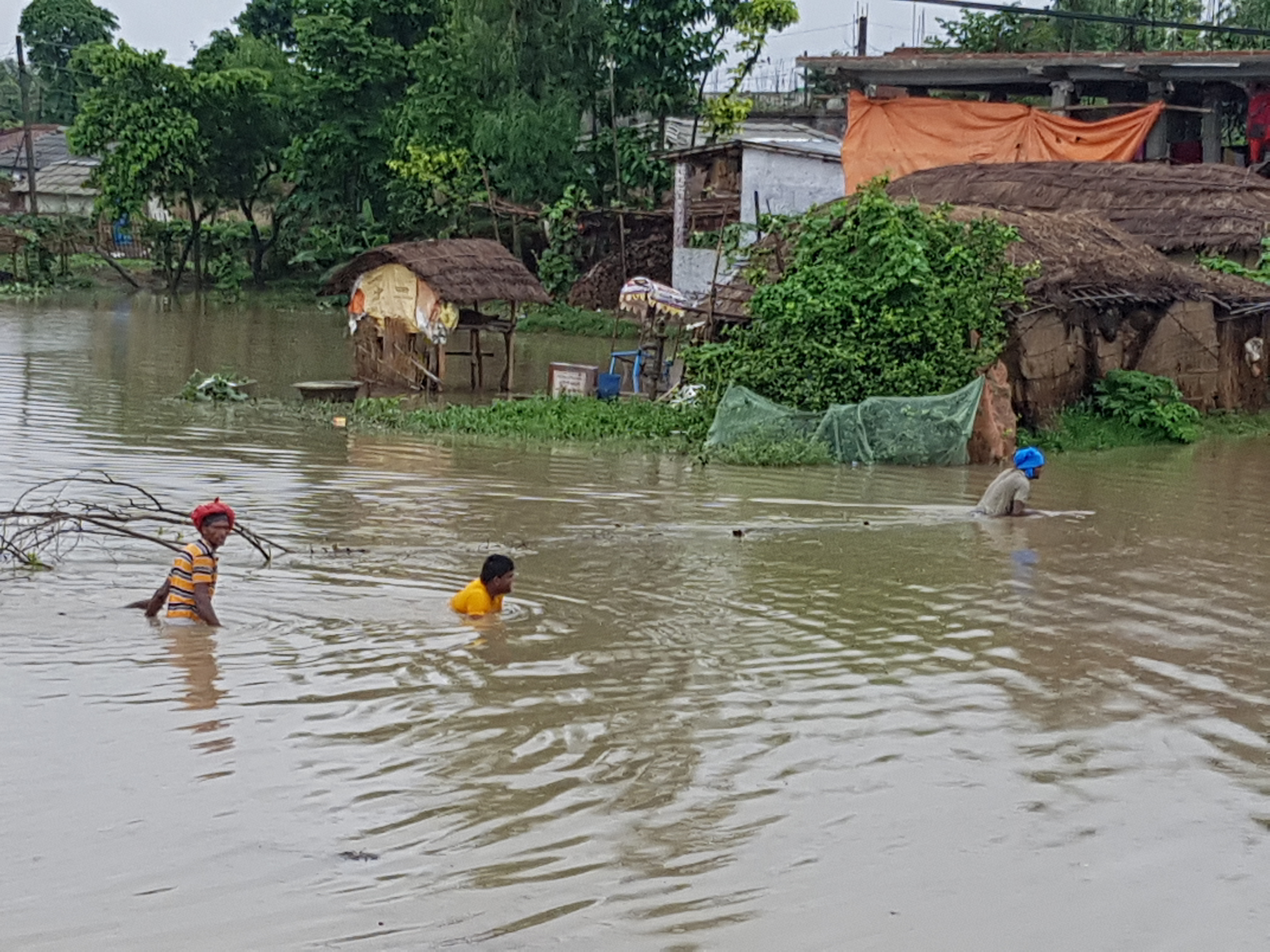Climate & Environment
Extreme rain pattern is unleashing more floods and landslides
County is faced with new weather adversity as death toll from water-induced disasters continues to rise.
Chandan Kumar Mandal
On Thursday, Amrit Mahato was in a tiny strip of land surrounded by Kamala River in Kalyanpur. Mahato, along with Santosh Sada, Reshama Devi Mahato and Anardevi Mahato from Hathamunda, Dhanusha, was there to harvest seasonal vegetables that they grow in that piece of land.
It was not that Mahato had not paid heed to the rising levels of water in the river when it rained. “But within a few minutes, the river started to swell, approaching the land where we were standing. We had nowhere to go.”
They were rescued by security personnel on Saturday morning.
It’s not the swollen river but the rain pattern which baffled Mahato, who has seen 75 monsoons.
“The light rain suddenly grew into a heavy downpour,” said Mahato. “And it continued.”
Until last week, farmers like Mahato were concerned about their paddy plantation. Monsoon had entered the country a few days late, and it had not been active. Rainfall had remained isolated throughout the country.
But over the last three days, the country has witnessed heavy rainfall in an indication of the changing rainfall pattern. The country is receiving more rainfall in a short duration of time—an abnormal phenomenon that is slowly becoming a new normal.
“There has been a change in precipitation in recent years. The intensity of rainfall has gone up,” Madhukar Upadhya, a watershed practitioner and climate change expert, told the Post. “We are experiencing a high intensity of rainfall in short durations.”
Data from Simara station of the Meteorological Forecasting Division show how the pattern of rainfall has changed in recent times.
Simara station received the highest rainfall in the latest wet spell. In the 24-hour period since Thursday evening, Simara recorded 311.9 mm rainfall, according to the Meteorological Forecasting Division.
The Simara station also surpassed its own extreme rainfall in 24 hours for July. The last incident of extreme precipitation in 24 hours was 266.4 mm in July 16, 1978. The amount of rainfall Simara received in the last 24 hours is more than half of its average rainfall of 580.2mm for that month. Only into the 13 days of the month, Simara has received 478.40mm of rainfall out of its monthly average of 580.2mm.
This intensity of rainfall looks unusual for Simara because the highest extreme rainfall ever recorded at the Simara station was 300.3mm on August 1, 1987.
“July is the most active month for monsoon, but the continued precipitation in the last few days is extreme in nature,” Manju Basi, a meteorologist at the Meteorological Forecasting Division, told the Post. “The increasing intense rainfall in a short period could be linked to climate change but we need more climate research to prove this.”
Different districts on Saturday also saw devastation and destruction by floods and landslides triggered by incessant rainfall.
According to the Home Ministry, floods and landslides claimed at least 32 lives until Saturday evening. Twenty-one people were missing, while 26 others were injured. The ministry said around 2,000 people had been rescued by Saturday evening.
There were at least seven deaths alone in Province 1 due to floods and landslides on Saturday.
In Province 2, around 80 percent of the land has been inundated. Gyan Bahadur Mahato, spokesperson for the Province 2 Police Office, said Rautahat has been affected the most. “A majority of the settlements in Rautahat have been flooded,” he said.
In Saptari, at least 15 houses were swept away and 2,500 houses inundated. Until Saturday, 1,500 families had been displaced.
In Morang, waters from the swollen Bakraha, Lohandra, Judi, Singhiya and Keshliya, among other rivers, gushed into nearby settlements, displacing around 4,000 people.
“The country has been struggling to fight against the natural phenomena of floods and landslides. Such erratic rainfall is definitely a new worry for the country,” Dhurba Gautam, a disaster management expert, told the Post.

A government study, “Observed Climate Trend Analysis of Nepal (1971-2014)”, based on the hydro-meteorological data of four decades from the Department of Hydrology and Meteorology, has shown that the gap between dry and rainy days has gone up although the total annual rainfall has been constant.
According to the report, which clearly projected signs of climate change impacts in the country, extreme rainfall has significantly increased in northwestern and northeastern districts of the country. The report also projects that the number of rainy days with more than 1mm of rainfall has increased, which was more significant in 12 districts. The number of wet days has, however, decreased considerably, mainly in the northern mountain districts, it says.
Another study predicted that Nepal’s climate is likely to get warmer and wetter in future, indicating an increase in intense precipitation events, but rainy days will slump down—meaning heavy rainfall in short span of time.
According to Upadhya, positioning of monsoon trough or low-pressure line and its stagnation at one point has also caused such intense rainfall in a particular area.
“Low-pressure line remains stuck above one area meaning more rainfall in one such area. For instance, there was a flood in Tarai districts, but Kulekhani reservoir remained dry. Last year, it rained non-stop for nine days in Kerala and there was almost no rainfall in the neighbouring state of Tamil Nadu,” added Upadhya.
More amount of rain in a short period of time could unleash dangerous floods and landslides, for which the country still seems to be ill-prepared.
Meteorologists and experts on disaster and environment say the country needs to adopt proper and timely measures to mitigate effects, as there is little anyone can do to control natural phenomenon.
“Every year in early June or weeks before monsoon enters the country, the Home Ministry holds a ritualistic but not action-oriented workshop with all concerned parties,” said Gautam. “But there is no post-assessment of the workshop or any medium-term or long-term plan other than the usual Monsoon Emergency Workplan.”
In Dhanusha, Mahato feels he survived because rescuers could reach him and his fellow villagers on time.
“Only after four minutes since we were rescued was the land where we stood swept away,” said Mahato said. “It feels like we’ve got a second life.”
Ajit Tiwari contributed reporting from Janakpur.




 14.12°C Kathmandu
14.12°C Kathmandu










